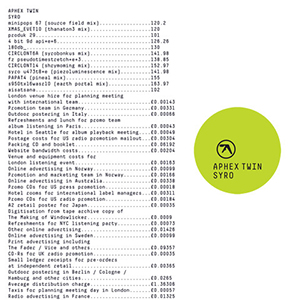Aphex Twin Syro
For once, maybe the blimp, the promotional graffiti, and the Deep Web browser links were […]

For once, maybe the blimp, the promotional graffiti, and the Deep Web browser links were justified: Syro is Richard D. James doing his best work of the last two decades. But like most things related to Aphex Twin, that’s a bit of a half-truth: both as The Tuss and via his Analord series, James has been quietly producing insular acid weirdness since the release of his last full-length, 2001’s Drukqs, and he’s been getting better at it all along. Syro feels more like a culmination than a sudden flurry of activity; it’s an effort that suggests James’ purported retreat into reclusivity was actually a case of good timing and a certain degree of calculation.
Early reviewers have remarked that there are no moments of jaw-dropping innovation on this album, but one could argue that Syro‘s refinements offer a different kind of future shock. The elastic pitch bends of James’ vocals set against hyper-compressed snares on “minipops 67 [120.2][source field mix]” references a similar trick culled from the now-ancient “Windowlicker,” but it’s a trick no one else has really bested since then. Similarly, “s950tx16wasr10 [163.97][earth portal mix]” offers an improvement on the drill & bass template by somehow un-dating it, combining the roll of early jungle, FM bass, and a grab bag of now-familiar rave tropes into a permutation that seems obvious only after hearing it.
Gear talk tends to be a snoozer for the uninitiated, but the album cover of Syro alludes to James’ hardware obsession, pointing out which pieces of gear were used on what and offering a presumably honest peak into his process. For instance, both “CIRCLONT6A [141.98][syrobonkus mix]” and “CIRCLONT14 [152.97][shrymoming mix]” were likely made using the Cirklon sequencer—a niche item that forgoes the computer in favor of a tiny LCD screen. These “old fashioned” gear choices are essential to the sound of Syro, as James’ mishmash of modern and retro techniques is as close to atemporal as electronic music gets.
Frequently, James’ mutant futurism renders certain sounds—cut-up breakbeats, fake hoovers, baroque basslines—as so deeply uncool that they somehow come back full circle. “produk 29 [101]” opens with playfully cornball lounge vibes, quickly shifting into a second movement of spoken-word cut-ups and an expanded melody that would sound perfectly natural backing Leonard Nimoy. “180db_ [130],” a stomping, hoover-led headfuck, is the soundtrack to a 43-year-old rave dad dropping some E’s and fackin’ ‘avin it after the kids have gone to bed. None of this is a grand departure from what we’ve come to expect from James, but he’s gotten so good at balancing his indulgences against his playfulness that Syro is ultimately as challenging as it is fun.
Admittedly, Syro will probably not win over a new generation of fans like the Richard D. James album once did, but as a continuation of everything that has made Aphex Twin compelling, it’s a triumph. Nobody else can fabricate music as impossibly dense, funky, and nuanced as this without losing sight of the big picture. If it’s true that James has been kicked back into gear after making this album, then Syro marks a fantastic new-ish beginning.

